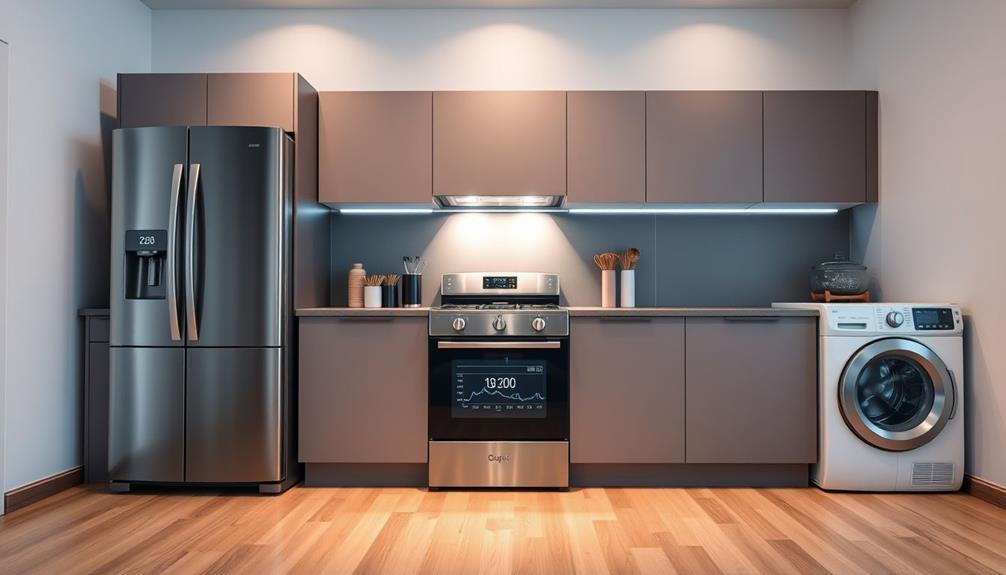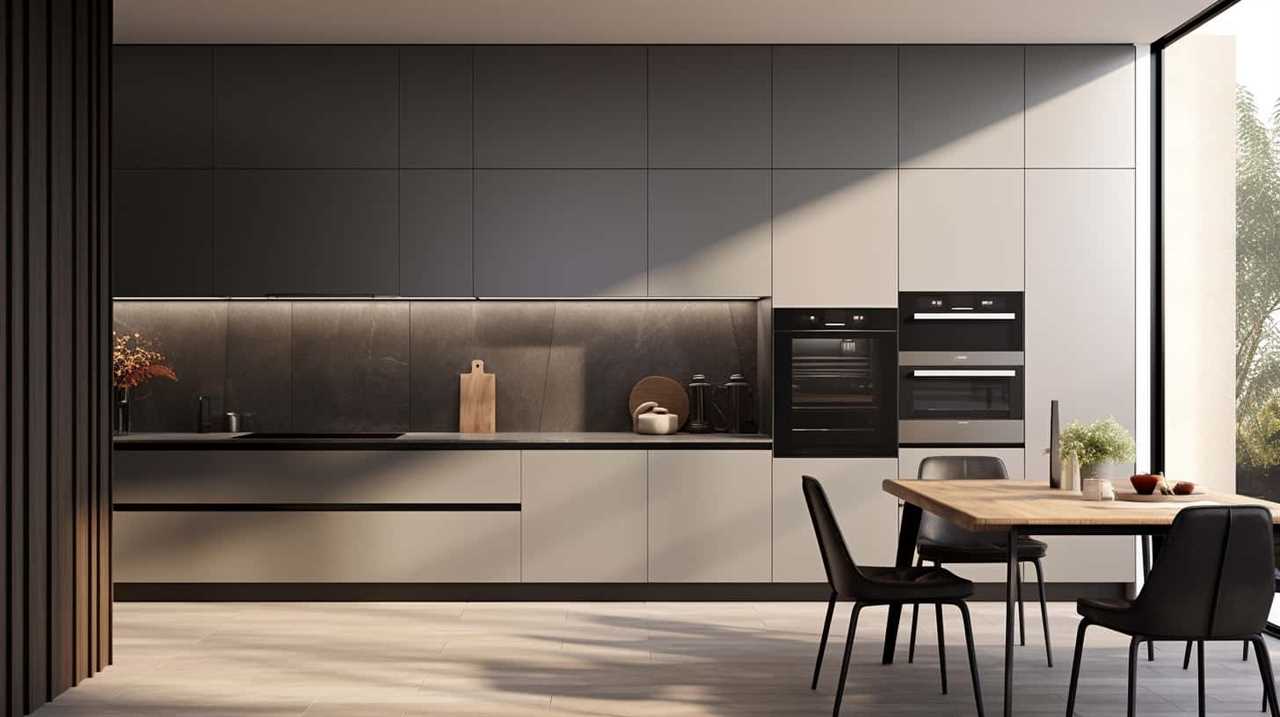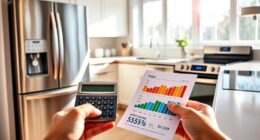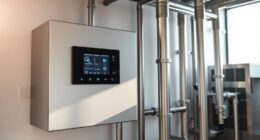Yes, intelligent appliances indeed conserve energy. Typically, you can anticipate savings ranging from 30-40%, depending on the specific device. For example, smart thermostats can reduce heating costs by 10-12% and cooling costs by 15%. Smart bulbs consume up to 75% less energy than traditional ones, while smart power strips assist in lowering overall household usage by approximately 10%. Your interaction with these devices is essential; utilizing energy monitoring tools can help you maximize your savings. The more you comprehend and control your energy consumption, the greater your savings will be. Explore how you can effectively utilize this technology for enhanced efficiency.
Key Takeaways
- Smart home devices can achieve average energy savings of 30-40%, enhancing overall energy efficiency.
- Smart thermostats can save 10-12% on heating and 15% on cooling costs, translating to significant annual savings.
- Smart bulbs use up to 75% less energy compared to traditional incandescent bulbs, contributing to reduced electricity bills.
- Active engagement with energy monitoring tools maximizes savings by helping users adjust consumption habits effectively.
- Overall home energy efficiency, including insulation, affects the performance of smart appliances and their energy-saving potential.
Energy Savings Overview
In today's world, your home's energy efficiency can greatly benefit from smart appliances. By integrating smart home devices, you can achieve energy savings of 30-40% on average, depending on the devices you choose and your household's unique characteristics.
One of the most effective tools in this arsenal is smart thermostats. They can help you reduce energy consumption by delivering reported savings of 10-12% on heating and 15% on cooling costs, particularly if you're upgrading from non-programmable models. Additionally, utilizing renewable energy sources, such as geothermal energy, can further enhance your home's sustainability and efficiency.
Additionally, smart bulbs and plugs play a significant role in energy reduction. They use up to 75% less energy than traditional incandescent bulbs and require minimal user intervention, making them an easy choice for your home.
However, to maximize energy savings, it's essential to engage with energy monitoring tools and set your devices correctly. Remember, the effectiveness of these smart appliances can be limited by older, energy-wasting features in your home.
Key Device Types
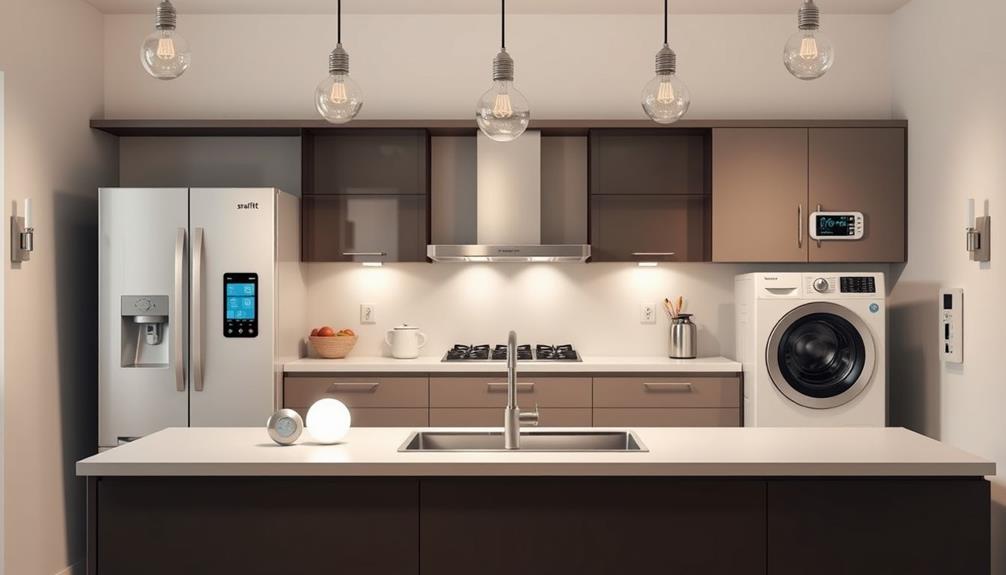
Smart appliances come in a variety of types, each designed to enhance energy efficiency and simplify your daily routines. Understanding these key device types can help you make informed choices that reduce energy use and lower your utility bills.
Here's a quick overview of some essential smart devices:
| Device Type | Energy Savings | Key Features |
|---|---|---|
| Smart Thermostats | 8-15% on utility bills | Programmable settings, remote access |
| Smart Bulbs | 75% less energy than incandescents | Voice control, scheduling |
| Smart Power Strips | Up to 10% of household use | Automatic shutoff for standby devices |
Smart thermostats can save you around 8% on utility bills, translating to about $50 annually for low-income households. Smart bulbs consume 75% less energy, while smart power strips prevent waste by shutting off idle devices. Additionally, energy monitoring systems allow you to track energy usage patterns, empowering you to adjust habits for even more savings. With a little engagement, these smart devices can greatly enhance your home's energy efficiency, helping you save both energy and money.
User Behavior Impact
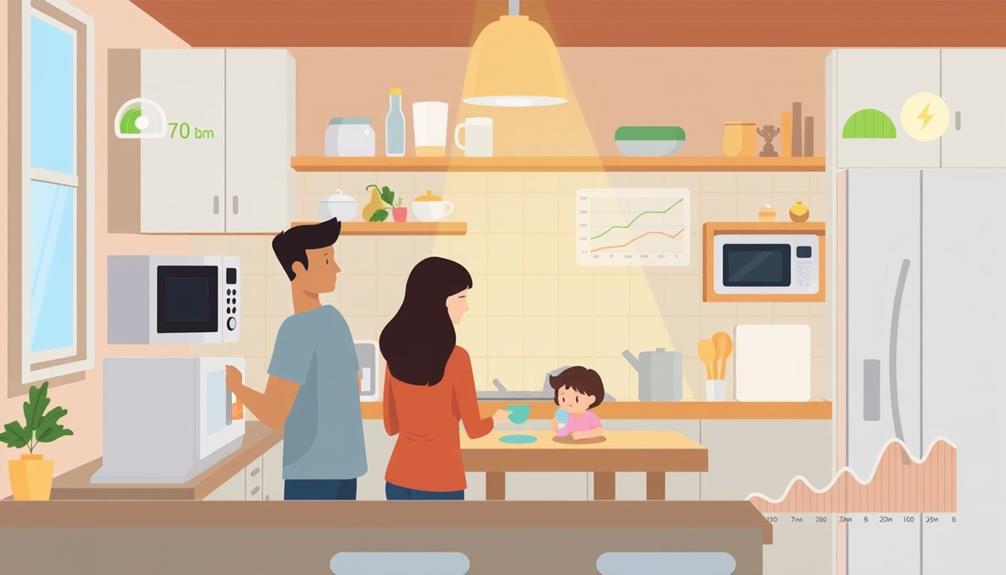
When you optimize your smart appliance settings, you release their full energy-saving potential.
For instance, using devices like air purifiers can greatly enhance the quality of your indoor environment while also improving energy efficiency, especially when you follow guidelines for optimal air purifier usage.
Your level of engagement with these devices also plays an essential role; the more you monitor and adjust, the more efficient they become.
Device Settings Optimization
Many homeowners underestimate the impact of their behavior on the energy efficiency of smart appliances. When you properly configure these devices, like smart thermostats, you can achieve notable energy savings—up to 8% on your utility bills. However, if you frequently override settings or fail to engage with energy monitoring tools, you might negate these benefits.
Additionally, understanding the energy consumption of appliances is vital, as many devices draw power even when not in active use, contributing to unnecessary costs energy consumption patterns.
Understanding your occupancy patterns is vital for device settings optimization. Utilizing features like geo-fencing can help schedule your appliances to operate only when you're home, maximizing energy efficiency while keeping you comfortable.
Your engagement with the smart devices directly influences their effectiveness, with informed users potentially seeing 30-40% overall energy savings.
It's also essential to bear in mind your home's overall efficiency. Factors like insulation and window quality affect how much energy your smart appliances can save.
User Engagement Levels
User engagement with smart appliances plays an essential role in determining energy savings. When you actively interact with smart technology, like smart thermostats, you can notably improve energy efficiency in your home.
AI security enhances overall security posture by protecting sensitive data, which is critical when managing smart appliances connected to the internet. Regular adjustments and proper settings are fundamental for maximizing those energy savings.
Research shows that users who engage with their smart thermostats can save between 10-12% on heating and 15% on cooling just by optimizing their usage patterns.
Understanding your user habits is essential. If you're not familiar with energy monitoring tools, you may miss out on the benefits they offer. Increased awareness leads to better energy management, allowing you to make informed decisions that enhance energy conservation.
However, incorrect settings or frequent overrides can negate the potential savings these smart devices provide.
Home Efficiency Considerations
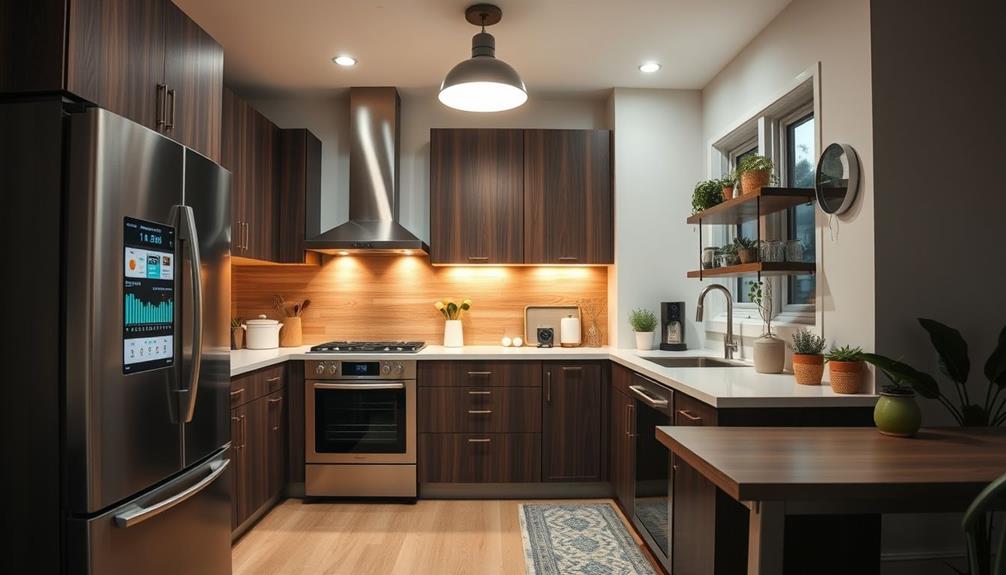
To truly benefit from smart appliances, you need to contemplate your home's overall energy efficiency. Even the most advanced smart devices can struggle to deliver energy savings if your home isn't up to par.
Older homes often come with single-pane windows and poor insulation, which can limit the effectiveness of these appliances. For instance, while a smart thermostat can markedly lower your energy bills, its performance hinges on the existing conditions of your home.
Additionally, smart devices like garage door openers can contribute to overall home security and efficiency, which ultimately helps in reducing energy waste.
Improving your insulation and sealing gaps can maximize the savings potential of smart appliances. When you create a well-insulated home environment, smart devices can work more efficiently alongside energy-efficient upgrades.
By strategically selecting compatible smart devices, you not only enhance their operational effectiveness but also create a cohesive system that effectively manages energy consumption.
Ultimately, to achieve the best results with smart appliances, consider a thorough approach to energy efficiency. This means addressing your home's structural weaknesses while implementing smart technology.
Integration and Communication
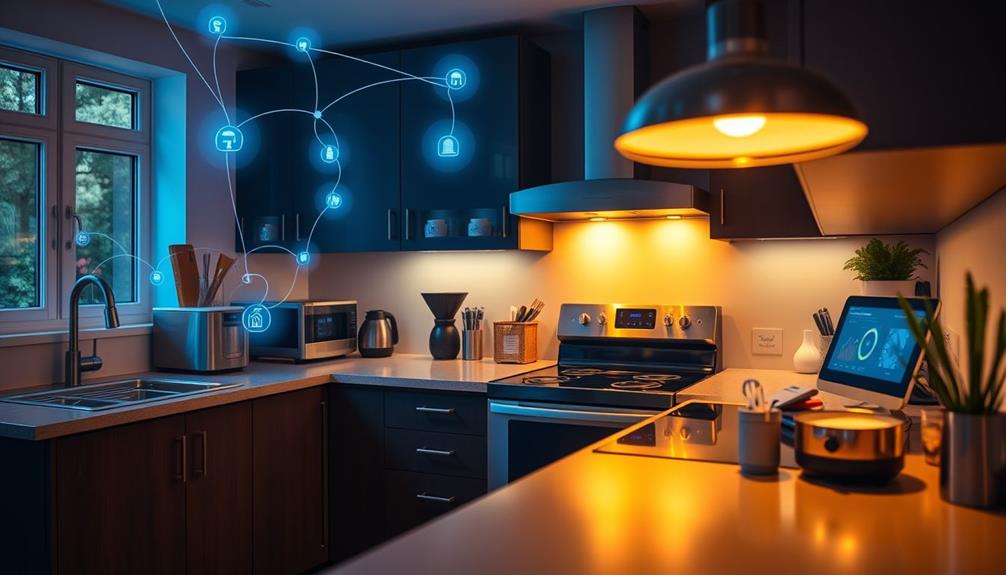
To maximize your energy savings, you need to guarantee your smart devices are compatible and can communicate effectively.
Integrating these technologies can lead to a more sustainable household, as AI-driven solutions adapt to emerging energy demands.
When devices like smart thermostats and plugs work together, they adjust energy usage in real-time, helping you save more.
Choosing the right communication protocols can make all the difference in creating an efficient smart home ecosystem.
Device Compatibility Importance
In today's smart home landscape, device compatibility plays an essential role in achieving energy efficiency. When you choose smart appliances that can seamlessly communicate with one another, you create integrated systems that optimize usage patterns and minimize unnecessary energy consumption.
It's imperative to select compatible devices, as mismatched appliances can lead to inefficiencies and hinder the overall performance of your smart home ecosystem. Recent trends in hackathons and skills development also highlight the importance of innovation in tech, which can extend to the development of smart appliances and their compatibility.
By connecting IoT devices through a unified platform, you enhance automation and scheduling, resulting in better energy management. For instance, energy monitoring devices can track your consumption patterns, but their true potential shines when integrated with other smart appliances that react in real-time to the data provided.
This synergy allows you to leverage features like scheduling and off-peak usage, ultimately maximizing energy savings. Comprehensive installation of compatible smart devices is key to strategic energy management, enabling you to fine-tune your energy efficiency efforts.
Effective Communication Protocols
Selecting compatible smart devices is just the first step; effective communication protocols among them take energy efficiency to the next level. By utilizing advanced technologies like Zigbee and Z-Wave, your smart home appliances can create low-power wireless connections that allow for seamless integration of compatible devices.
This synergy enables real-time data sharing, helping your appliances coordinate actions based on user behavior and environmental conditions. Additionally, exploring various best websites to earn money online can provide insights into how to invest in energy-efficient technologies.
With energy monitoring devices in place, you'll gain insights into your consumption patterns, empowering you to make proactive adjustments. A well-integrated smart home ecosystem can achieve impressive energy savings—up to 30-40%—by ensuring that devices work in unison, reducing consumption during peak usage times or when your home is unoccupied.
When your appliances communicate effectively, you not only enhance energy efficiency but also contribute to a more sustainable lifestyle. So, focus on establishing robust communication protocols among your smart devices to maximize their potential and achieve significant energy savings.
Environmental Contributions

Harnessing the power of smart appliances can lead to significant environmental contributions by optimizing energy use in your home. These devices enhance energy efficiency by reducing waste, which directly lowers your household's overall energy consumption.
For instance, smart thermostats can save you an average of 10-12% on heating and 15% on cooling, effectively shrinking your carbon footprint. Additionally, the rise of online shopping and the significance of efficient payment processing (efficient credit card processing) can contribute to a decrease in energy use by reducing the need for physical retail spaces.
Moreover, smart homes equipped with energy monitoring devices provide valuable insights, helping you adjust your consumption habits to further support environmental sustainability. By utilizing renewable energy sources, such as solar panels, smart appliances can greatly decrease your reliance on fossil fuels, playing an essential role in climate change mitigation.
Here are some key contributions of smart appliances to the environment:
- Reduced carbon footprints through optimized energy management.
- Enhanced energy efficiency that cuts down on wasteful usage patterns.
- Increased use of renewable energy, leading to a more sustainable future.
The widespread adoption of these technologies is imperative for achieving global environmental targets and reducing emissions from residential sectors.
Frequently Asked Questions
Do Smart Appliances Save Energy?
Yes, smart appliances can save energy. By optimizing usage based on your habits and integrating with energy management systems, you'll likely notice significant reductions in your utility bills and a smaller carbon footprint.
Do Smart Appliances Collect Data?
You'd think smart appliances are spies in your home! They absolutely collect data on your habits and preferences, adjusting automatically to enhance efficiency. This constant monitoring gives you insights into your energy consumption like never before!
Do Energy-Efficient Appliances Save Money?
Yes, energy-efficient appliances save you money. By consuming less energy, they lower your utility bills. Investing in models like smart thermostats or LED lights can lead to significant savings over time, benefiting your budget.
How Does a Smart Uses Iot to Save Electricity?
Imagine your home as a wise sage, guiding you toward energy savings. Smart appliances, like attentive students, use IoT to learn your habits, adjusting usage and optimizing consumption, ultimately helping you save electricity effortlessly.
Conclusion
So, if you thought buying a smart appliance would magically turn your home into an energy-saving utopia, think again! Sure, they can save energy, but only if you don't accidentally leave them on while binge-watching your favorite show. It's like having a pet that promises to fetch the newspaper but ends up chewing it instead. So, embrace the tech, but remember: the smartest appliance in your house is still you—just don't forget to turn it off!
